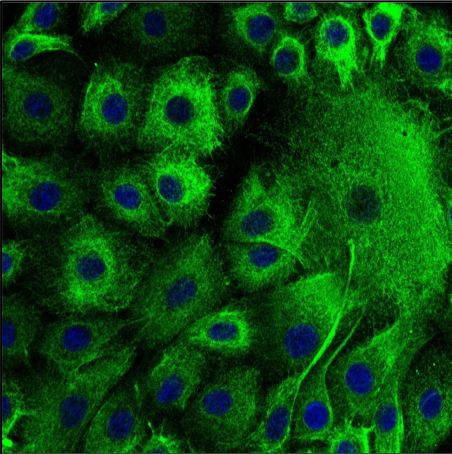Collaboration seeks new stem cell treatment for mastitis
Collaboration seeks new stem cell treatment for mastitis
Novel approach to udder infection is target of new project
Apart from antibiotics, dairy farmers have few tools to treat the common and costly udder infection mastitis. To add to their tool kit, a team led by Dr. Gerlinde Van de Walle of the Baker Institute is exploring compounds secreted by stem cells as a potential therapy that may kill the bacteria while healing the damage they leave behind.
The new project stems from a unique collaboration between the Baker Institute for Animal Health, part of the Cornell College of Veterinary Medicine (CVM), and Elanco, a leading animal health company. Funding for the work comes from the Foundation for Food and Agriculture Research (FFAR), the New York Farm Viability Institute (NYFVI) and Elanco. All together, the project will receive $1.38 million, with about half coming from FFAR. While the research is still in early stages, the team hopes it will provide proof of concept that stem cell compounds have potential for treating mastitis and perhaps other diseases as well.
“The long-term goal would be a natural product that could be an adjunct or even a replacement for antibiotics,” said Van de Walle, “that in itself would be huge.”
“Infections like mastitis, common in dairy cattle, are a major concern among producers as these infections are costly and result in decreased milk production,” said FFAR’s executive director Dr. Sally Rockey. “FFAR is thrilled to support this bold research that is identifying alternative treatments to mastitis. If the treatment is effective and affordable, it has the potential for adoption across dairy farms nationwide, resulting in enhanced milk production and farmer profitability.”

Besides impacting the health of cows, mastitis is a major economic problem for dairy farmers. “Mastitis is the highest incidence disease and the costliest infectious disease of the dairy industry,” said team member Dr. Daryl Nydam, faculty director of the Cornell Atkinson Center for Sustainability and professor of dairy health and production at CVM. The infection causes a drop off in milk production and quality, and if antibiotics are required, the milk must be discarded to prevent contamination of the milk supply with antibiotic residues. While antibiotics are sometimes useful for clearing the infection, depending on pathogen, they can’t repair the resulting damage in the mammary gland, and so milk production levels may never recover. “We’re hoping this approach both rids the cow of the bacteria and restores closer to normal milk production,” said Nydam.
In a 2018 study in Scientific Reports, Van de Walle and Nydam used cell cultures grown in the lab to investigate the effects of “the secretome” – the total collection of secreted compounds – from adult stem cells from bovine mammary tissue. The preliminary work by their students showed that the secretome had antimicrobial properties by killing bacteria, prevented damage from bacterial toxins, and promoted healing through the growth of blood vessels and recruitment of new cells.
Now, with help from Elanco, they will perform similar experiments with the secretome, but this time in actual cows. “We find really amazing things in the lab, but we don't always have the opportunity to continue working on it and pursue it in the live animal,” said Van de Walle. “Working with Elanco is crucial, because they have the facilities and cow models that will allow us to test these secreted biomolecules,” said Van de Walle.
“Mastitis is one of the main disease targets for Elanco,” said Dr. Leane Oliveira, a principal research scientist at Elanco. The disease is the main reason that dairy farmers use antibiotics, and within concerns over the rise of antibiotic-resistant bacteria, Elanco aims to provide farmers with innovative alternatives.
Elanco got involved when Dr. Lucas Huntimer, a senior advisor for external innovation at the company, reached out to Van de Walle after reading the 2018 paper. He suggested applying to FFAR, a non-profit that funds research that addresses major agricultural problems through public-private partnerships. To apply, however, the project needed equal contributions from research partners. Elanco stepped up to offer financial support and Huntimer, Oliveira and their team of scientists will be performing the in-cow experiments at their facilities.
Grusenmeyer points out that organic dairy farms would especially benefit from an alternative mastitis therapy, as they can’t use antibiotics for their cows. According to the Pew Research Center, New York is the state with the most organic dairy farms, numbering 471 in 2016.
Cornell is also contributing to the project through salary support to Nydam, and collaborators Dr. Anja Sipka and Dr. Paolo Moroni from Quality Milk Production Services.
In their experiments, the team plans to treat cows with mastitis using different components of the secretome, to pinpoint which bioactive compounds are responsible for its beneficial effects. In the treated cows, they’ll be looking for any antimicrobial effects, differences in milk production, signs of healing and regeneration of the mammary tissue, and changes in the bovine immune system that may help fight the infection.
The researchers will also be comparing the effects of different types of bovine stem cells. “There's so much unharnessed innovation in the area of stem cells and the secretome that it's fun to have the opportunity to explore novel potential therapies that may come out of that,” said Huntimer.
If the work can be translated into a novel mastitis therapy, Nydam and Grusenmeyer expect that farmers will be receptive to the treatment, as long as it is effective and affordable.
The new work in cattle is a return to the early years of the Baker Institute, when research focused primarily on diseases of livestock. Returning to this area may create new opportunities for Van de Walle and the Institute to increase the health and productivity of farm animals.


